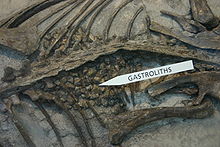Gastrolith
Gastroliths (Ancient Greek γαστήρ gaster 'belly', 'stomach' and λίθος lithos 'stone') or stomach stones are hard objects in the digestive tract of animals. In a narrow sense, gastroliths refer to stones that have been swallowed by vertebrates and are or were in the stomach. Animals that ingest stones are also called lithophages ('stone eaters').
Among animals living today, the behavior of swallowing stones (lithophagy) is known mainly from birds, crocodiles and seals. Fossils of dinosaurs such as the sauropods or other reptiles such as the tangasaurids from the Permian, fossil crocodiles and plesiosaurs are known in which stomach stones are found in the abdominal region of the skeleton.
The function of the stones has so far only been fully clarified in herbivorous birds. In them, the swallowed stones, which are also called "grit" or "woad grains", serve in the gizzard (ventriculus) for the comminution of food. The Rock Capercaillie, for example, is obligatorily dependent on gastroliths and even downy young ingest them. The Rock Capercaillie feeds mainly on the budded terminal shoots of the larch in the winter months. These terminal shoots have a thick bark and cambium layer. During the primary processing of these terminal shoots in the stomach, these layers are rubbed off with the help of the gastroliths, so that only the pith of the stem, about one millimetre thick, remains of the buds, which are three to five millimetres thick. In water-dwelling (aquatic) animals that do not have very muscular stomachs, it is debated whether stomach stones might also serve as ballast. Perhaps most of the stones are also just accidentally swallowed with the food.
Calcareous mineral crusts or concretions formed inside crustaceans, known as crustacean eyes, are also called "gastroliths" and serve as temporary stores for minerals needed during molting.
In veterinary medicine, the term is used to describe pathological, i.e. diseased, concretions formed from food residues and gastric juices in the stomach of herbivorous mammals. These objects are also called bezoars.

A diplodocid ingests stones while eating a palm fern (Cycadophyta).

plesiosaur gastroliths

Gastroliths in the stomach region of a Psittacosaurus
Questions and Answers
Q: What are gastroliths?
A: Gastroliths are small rocks that animals keep inside their stomach or early parts of the alimentary canal.
Q: What is the function of gastroliths?
A: The function of gastroliths is to mash up food, allowing for faster digestion. They also serve as a substitute for teeth for grinding in animals that lack suitable teeth.
Q: Which animals typically use gastroliths?
A: Animals that lack suitable teeth for grinding typically use gastroliths as a substitute.
Q: Why do aquatic animals utilize gastroliths?
A: In aquatic animals, gastroliths can be used for ballast, which makes diving easier.
Q: How do gastroliths help animals with digestion?
A: Gastroliths mash up the food, allowing for faster digestion.
Q: What is the difference between gastroliths and teeth in animals?
A: Gastroliths serve as a substitute for teeth in animals that lack suitable teeth for grinding.
Q: Can animals digest gastroliths?
A: No, animals cannot digest gastroliths as they are just rocks. They don't serve a nutritional purpose.
Search within the encyclopedia